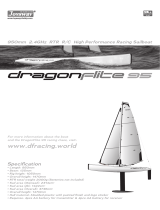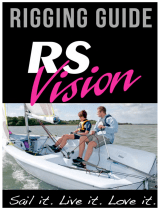Page is loading ...

Product review – 2014 HOTT Micro Magic RTR – Part 2. Rigging and Instruction Manual
By Mike Eades MM #15 & 315
Here again the product literature online seemed to indicate that the HOT RTR Micro Magic was rigged
exactly like the former Racing MM RTR version and the Racing MM kit. What came out of the box was
quite a mixture! Part standard MM rig kit, part borrowed from John Tushingham’s popular “Graphite”
rigs.
Sails – Single panel rip-stop polyester, heavier weight than the old standard Icarex kit sails but same as
previous RTR version. Battens and small holes for attachment locations are in place but the holes
needed enlarging.
- Main has double line at clew for attachment to boom, very little luff curve was evident. Sail
foot was cut to allow for inverted gooseneck. Metal luff rings as per kit were supplied.
- Jib has double line at clew for attachment to boom. Forestay was installed terminating top
and bottom in a small metal ring (A much used “Graphite” fitting!). Halyard also attached to
the upper metal ring (Figure 1). A downhaul line is attached to the tack for attachment to a
boom sliding adjuster (collet) (Figure 2).
Mast – 2-Piece carbon spar.
- 5 mm tube packed at lower end with wood dowel and epoxy full length from crane to base
of hull (like kit).
- 6 mm carbon tube sleeve from base of jib hanger to just below the deck plate.
- Crane is standard MM racing kit component with backstay, bowsie and loop for attachment
to transom knob. Double line for attachment of sail head.
- Jib Hanger is standard MM Racing kit with shrouds & bowsies (I removed these as
unnecessary!) attached to inner hole. Small piece of line terminating in a small metal ring is
attached to the jib hanger bracket (A “Graphite” rig feature) (Figure 3).
Gooseneck – Racing MM Standard component
Main Boom – two plastic collars replace the clew clip attachment and two more collars locate the sheet
attachment, which use another small metal ring (Figure 4).
Jib Boom – End caps, counter weight and two sliding collets are standard MM racing kit but each collet,
for downhaul and sheet attachment respectively, is prevented from sliding by a plastic collar. The
topping lift and bowsie is attached to the aft end cap. The jib pivot attachment is a small metal ring
attached to the boom located between two plastic collars (“Graphite” feature).
Instruction Manual – While for the simple steps of assembling the hull and appendages the Manual was
reasonably accurate, although plagued by some quaint translations, the photos and instructions for
rigging were unfathomable and inaccurate in many places. Best ignored!

Rigging – here are the steps I took in rigging the boat, set out in some detail in the hope it might help a
new skipper through the process. In a few minor areas I strayed from the RTR package for reasons I will
explain.
Main Sail, Mast and Gooseneck:
1. Tie the head of the main sail to the crane using the double line.
2. Tie loops of “Spider Wire” Spectra fiber line through the sail luff holes and around the mast. I
don’t care for the wire “mast loops” and never use them. Tie a reef knot followed by another
half hitch at each point. Make sure to leave a gap of approx. 2 mm between the mast and the
sail (Figure3).
3. Tie the clew to the boom with loops located between the two plastic collars (Figure 4).
4. Using a supplied loop of line with a bowsie, thread the loose end up through the white plastic
tube in the gooseneck brackets and tie it to the sail tack (Figure 5 shows the finished main
boom).
Jib:
1. Slide the counter weight off the pin in the jib boom end cap and slide on the metal ring at the
lower end of the forestay. Replace the counter weight with a drop of CA glue to secure it on the
pin. Thread the line from the jib tack through the hole in the tab at the top of the end cap then
run it through the two holes in the small collet and tie it off so that the collet has room to slide
aft to increase luff tension. (Or tie jib tack line directly to the forward plastic sleeve and remove
the collet. Same can be done to the line terminating in a metal ring for jib sheet attachment!)
2. Tie the sail clew to the jib boom with loops locating them between the two plastic collars (Figure
6 shows the jib boom at this stage).
3. I removed the metal ring tied to the boom for attachment of the jib pivot. It can be used but I
believe a simple line attached to the boom by a Fisherman’s knot is preferable. In the supplied
components was a loop of line with bowsie with a small metal ring on the free end. I tied the free
end, as described, to the boom locating between the two plastic collars (Figure 7 shows the
finished Jib Boom).
4. Tie another piece of line to the metal ring holding the top of the forestay and the halyard using a
Fisherman’s knot. Run the free end up through a bowsie then through the metal ring attached to
the jib hanger bracket and tie loosely to the end of the bowsie.
5. Tie the free end of the topping lift to the same metal ring attached to the jib hanger bracket.
(Figure 8 shows the finished Jib head rig.)
6. Finish off the knots by burning all line ends and placing a very small dab of thin CA on all knots. At
this point the unshipped rig will appear as in Figure 9.
Rigging the boat:
1. Install the mast in the deck plate and ensure the two tabs on the bottom of the gooseneck are
properly engaged in the deck plate.

2. Attach the loop in the main sail downhaul to one of the shroud attachment eyes at the edge of
the deck and take the slack out of the line with the bowsie.
3. Attach the jib pivot line to the forward deck hook with the metal ring and loop the line over the
aft deck hook and tighten the bowsie until the jib boom is approx. 1 cm above the forward hook
(Figure 10).
4. Attach the backstay by placing the loop over the transom button. Take out the slack in the
backstay.
5. Adjust the position of the jib forestay bowsie so that it is mid-way between the two metal rings
with the mast very slightly bent aft.
6. Take out the slack in the topping lift.
Sheet line attachments:
1. With the electronics connected to battery and receiver, itself bound to its transmitter energize
the system put the sail winch travel at fully close-hauled position. Using a colored marker mark
the main sail sheet line at a point approx. half way between the fairlead exit in the aft cockpit
and the main boom. Similarly mark the jib sheet line at a spot 2-3 cm from the fairlead exit on
the deck.
2. Tie the sheet attachment clips to each line as close to the marks as you can get.
3. When rig is installed and all lines are adjusted this is how the rig will appear (Figure 11).
4. The final “Ready To Sail” weight was 990 gm including my 5-AAA cell 1000 mah NiMH battery
and Spektrum AR6100e RX.
Sailing performance:
I gave the MM RTR its first sea trials in rather extreme conditions, very shifty and variable winds (0-12
mph,) on a short course racing against a fleet of fully competitive class legal boats. After some tuning
adjustments the RTR faired well in straight line sailing but the higher weight showed up as a slight
disadvantage in stop-go and quick maneuvering conditions. All in all I conclude that the new RTR Micro
Magic is very well built and can be rigged very nicely with supplied components. It will make an excellent
all around club boat and a good addition to the fleet. For the top class competitor the weight of the
boats is a concern unless Graupner lightens the hull and/or the Class makes Rule adjustments to
accommodate the new product offerings.
Figure 1 Figure 2

Figure 3 Figure 4
Figure 5 Figure 6
Figure 7 Figure 8

Figure 9 Figure 10
Figure 11
/




